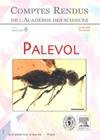Lutrinae Bonaparte, 1838(食肉目,鼬科),来自埃塞俄比亚西南部下奥莫河谷的上新世-更新世:图尔卡纳水獭的系统学和古生态学和古生物地理学的新见解
IF 1.3
4区 地球科学
Q3 PALEONTOLOGY
引用次数: 1
摘要
我们描述了来自埃塞俄比亚西南部下奥莫山谷的plio -更新世的水獭遗骸(Lutrinae Bonaparte, 1838)。我们报道了分离的约3.3 Ma的Torolutra sp.的上下牙齿,1868年的Enhydriodon Falconer的牙齿标本和股骨,归属于一个新种,约3.4 Ma至2.5 Ma之间,以及Lutrinae indet的肱骨。年代在约1.9至1.8 Ma之间。新种Enhydriodon omoensis n. sp.是迄今为止发现的该属中最大的种。它甚至比它的近亲E. dikikae Geraads (Alemseged, Bobe & Reed, 2011)还要大。E. dikikae Geraads是一种上新世狮子大小的水獭,来自阿法尔地区,可能来自图尔加纳东部。根据稳定的氧和碳同位素分析,我们发现来自Lower Omo Valley的Enhydriodon可能是陆生动物,以水生和陆生猎物为食,通过狩猎或食腐获得。它在过去与南方古猿共存的群落中占据了一个独特的生态位。Enhydriodon和Torolutra Petter, Pickford & Howell, 1991,在上新世到更新世的过渡时期在非洲灭绝了,同时灭绝的还有许多大型的、生态上专门的食肉动物。这次灭绝事件可能与这一时期东非裂谷发生的许多地质、气候和生物变化有关,尤其是早期人类入侵食肉动物行会。本文章由计算机程序翻译,如有差异,请以英文原文为准。
Lutrinae Bonaparte, 1838 (Carnivora, Mustelidae) from the Plio-Pleistocene of the Lower Omo Valley, southwestern Ethiopia: systematics and new insights into the paleoecology and paleobiogeography of the Turkana otters
We describe otter remains (Lutrinae Bonaparte, 1838) from the Plio-Pleistocene of the Lower Omo Valley of southwestern Ethiopia. We report isolated lower and upper teeth of Torolutra sp. dated to c. 3.3 Ma, dental specimens and a femur of Enhydriodon Falconer, 1868, attributed to a new species, dated between c. 3.4 Ma and 2.5 Ma, as well as a humerus of Lutrinae indet. dated between c. 1.9 Ma and 1.8 Ma. The new species Enhydriodon omoensis n. sp. is the largest species of the genus discovered so far. It is even larger than its close relative E. dikikae Geraads, Alemseged, Bobe & Reed, 2011, a Pliocene lion-sized otter from the Afar region and potentially from eastern Turkana. Based on stable oxygen and carbon isotope analyses, we found that Enhydriodon from the Lower Omo Valley could have been terrestrial and fed on both aquatic and terrestrial prey, acquired by either hunting or scavenging. It filled a unique ecological niche in the past communities co-existing with australopithecines. Enhydriodon and Torolutra Petter, Pickford & Howell, 1991 went extinct in Africa around the Plio-Pleistocene transition, along with many large-sized and ecologically specialized carnivorans. This extinction event could be linked to the many geological, climate, and biotic changes occurring in the eastern African rift during this period, notably the incursion of early hominins into the carnivore guild.
求助全文
通过发布文献求助,成功后即可免费获取论文全文。
去求助
来源期刊

Comptes Rendus Palevol
地学-古生物学
CiteScore
2.10
自引率
0.00%
发文量
39
审稿时长
17.6 weeks
期刊介绍:
Comptes Rendus Palevol is a fully electronic and peer-reviewed journal, with a continuous publication stream, devoted to palaeontology, prehistory and evolutionary sciences. It publishes original research results, in French or English, in the following domains: systematic and human palaeontology, prehistory, evolutionary biology and macroevolution, and history of sciences. Thematic issues may also be published under the responsibility of a guest editor. All articles published in Comptes Rendus Palevol are compliant with the different nomenclatural codes. A copyright assignment will be signed by the authors before publication.
 求助内容:
求助内容: 应助结果提醒方式:
应助结果提醒方式:


